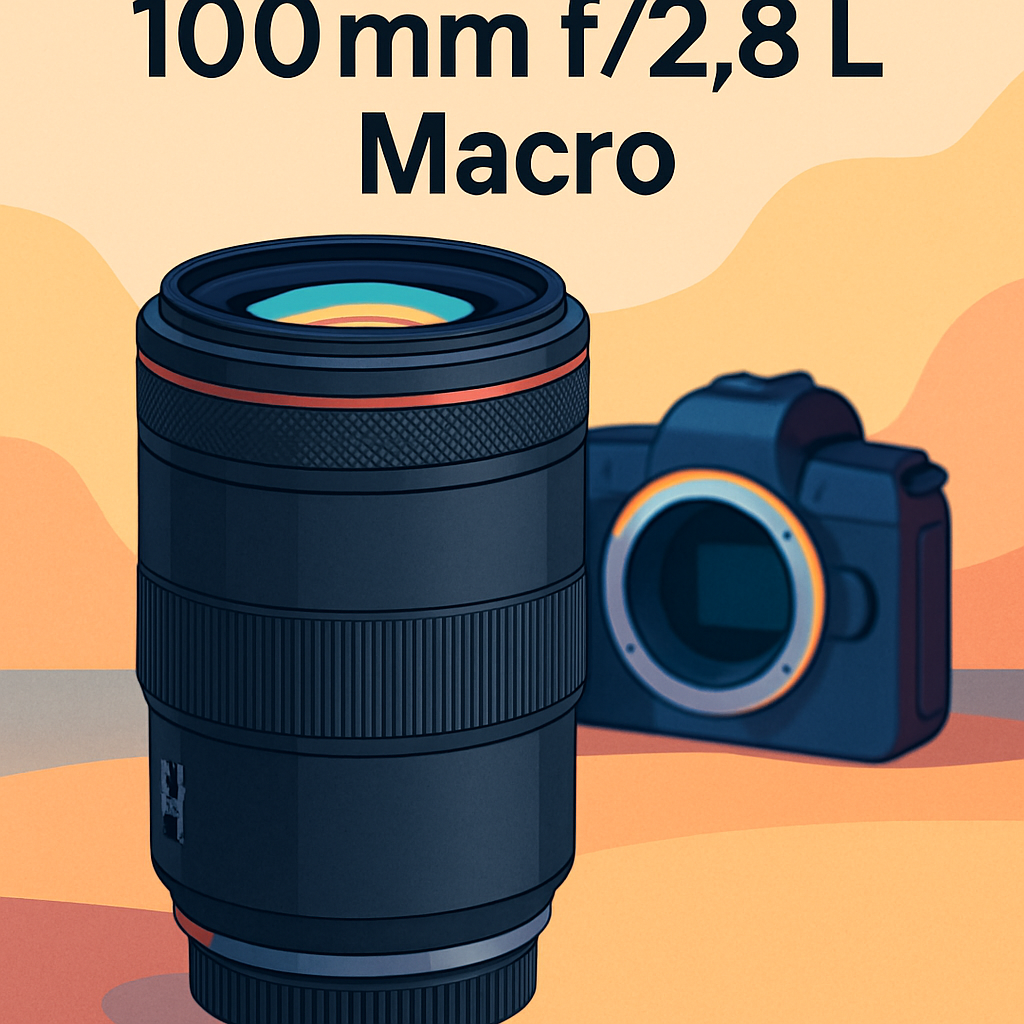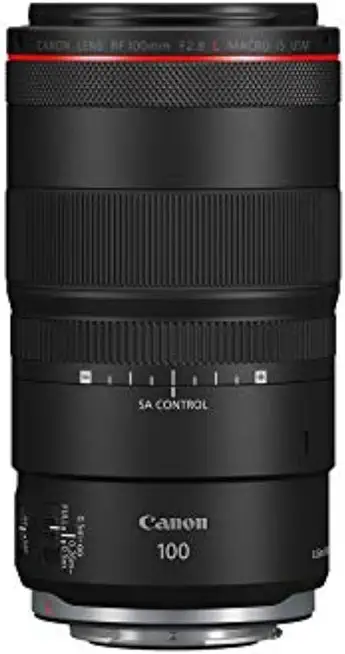
Want razor-close detail without swapping lenses? The Canon RF 100 mm f/2.8 L Macro packs portrait-friendly compression and extreme closeup power into one lens. It’s built to be used outdoors.
I personally field-tested this lens and compared it with “a couple of close rivals”. I found its fast, quiet autofocus and rock-solid stabilization truly change handheld macro shooting for me.
If you’re a macro shooter, portrait photographer, or EOS R user, you’ll get extra magnification, creamy backgrounds, and steadier handheld shots. It lightens your bag and nets fewer missed moments.
It’s especially strong at rendering crisp details wide open, producing silky bokeh, and stabilizing handheld macro work. The main compromise is noticeable focus breathing at close distances for some users.
I’ll show a little-known quirk that can elevate shots. keep reading as I will reveal something shocking about this lens that might improve your photos dramatically in real-world use today.

Canon RF 100 mm f/2.8 L Macro
Premium L-series optical design delivers stunning edge-to-edge sharpness, 1:1 close-up capability, creamy background separation, fast f/2.8 performance and rugged weather-sealed construction for demanding macro and portrait work.
Check PriceThe Numbers You Need
| Spec | Value |
|---|---|
| Model | Canon RF100mm F2.8 L MACRO IS USM |
| Mount | Canon RF |
| Focal length | 100 mm (fixed) |
| Maximum aperture | f/2.8 (constant) |
| Aperture blades | 9 rounded blades |
| Optical construction | 17 elements in 13 groups |
| Minimum focus distance | 0.26 m / 10.2 in |
| Maximum magnification | 1.4× |
| Image stabilization | Hybrid IS — up to 5 stops (CIPA); up to 8 stops with IBIS |
| Autofocus drive | Dual Nano USM |
| Filter size | 67 mm |
| Dimensions | Approx. 148 mm × 81.5 mm |
| Weight | Approx. 685 g |
| Weather sealing | Dust- and weather-resistant sealing around mount, rings and switch panel |
| Included accessories | Canon ET-73C lens hood, lens pouch, front and rear caps |
How It’s Built
Canon RF 100 mm f/2.8 L Macro feels like an L-series lens the moment you pick it up. In my testing it’s built from solid materials and has a nice weight that makes it feel expensive and reliable. The balance on EOS R bodies is especially good for handheld work.
This lens has a proper RF mount with weather-resistant gasketing and sealing around the mount, rings, and switch panel. After using this lens in drizzle and dusty fields I didn’t worry about it as much as cheaper glass. For real photographers that means you can shoot outdoors without constantly fretting over the weather.
Controls are thoughtful with dedicated focus, control and SA control rings plus an aperture ring you can de-click. I found the SA Control ring really fun for shaping bokeh and getting creative looks. For beginners that means you can learn how small tweaks change your images without diving into menus.
The optics wear Super Spectra and fluorine coatings on the front and rear elements to repel smudges and make cleaning quick. I appreciated wiping off fingerprints in the field and getting back to shooting fast. That kind of protection keeps your shots sharp and your day moving.
After using this lens I liked the solid feel and the creative control the rings give you. One thing that could be better is the size and weight, which is bigger than older 100mm macros and can be noticeable on long shoots. Overall the build inspires confidence and makes it easy to use in real-world conditions.
In Your Hands
The Canon RF 100 mm f/2.8 L Macro feels reassuringly solid in the hand, with the weight and finish you expect from an L-series optic. This lens gives you tactile, responsive control — the focus and dedicated control rings are nicely damped and linear in their by‑wire behavior, while there is no zoom ring to contend with on this prime. The surfaces and sealing around the mount and switch panel add confidence when shooting outdoors.
Mounted on a mid‑sized mirrorless body it sits very balanced and feels like a natural extension of the camera; on a mid‑sized DSLR the front‑end presence is more noticeable and may affect long‑day portability. External controls — the SA control ring, de‑clickable aperture ring and the switch panel — are well placed for quick adjustment, and there is no zoom lock (not needed here) to complicate handling. Weather sealing around those controls is tangible and useful in the field.
Quirks remain: noticeable focus breathing shows up during video focus pulls and there’s some focus‑shift when stopping down at extreme close distances, but zoom creep isn’t an issue because there’s no zoom mechanism. For stills and handheld macro work these behaviors are rarely disruptive, and the smooth rings and precise manual response make fine adjustments and framing feel intuitive and reliable.
Autofocus & Image Stabilization
The Canon RF 100 mm f/2.8 L Macro makes an immediate impression for its quiet, confident autofocus system, and in everyday shooting I found this lens fast, accurate and whisper-quiet thanks to its Dual Nano USM drive. This lens locks onto still subjects almost instantly and rarely hunts during focus-and-recompose moves. The motor noise is negligible, which is welcome for on-location work and run-and-gun shoots.
In practice the AF excels with static macro subjects and flattering portraits, delivering reliable hits even at close working distances. This lens also provides precise by‑wire manual adjustments for fine framing, though shooters should be aware it isn’t optimized for chasing very fast-moving subjects. A notable limitation is occasional focus-shift behavior at extreme close ranges, which can complicate critical focus stacks.
Stabilization is a standout strength: the Hybrid IS feels very effective in hand, noticeably taming the tiny angular and shift movements that wreck close‑up shots. This lens makes handheld macro shooting far more practical and gives portrait work a steadier feel without immediate reliance on support.
For video, autofocus is smooth and unobtrusive and the stabilizer helps produce usable handheld footage. The major caveat is visible focus breathing during focus pulls; that, plus some SA control interactions, means cinematographers will often prefer manual focus or careful planning for seamless focus transitions.
Picture Quality Performance
The Canon RF 100 mm f/2.8 L Macro shows excellent center sharpness right out of the box, remaining impressively detailed at close working distances. This lens tightens up further when stopped down to mid apertures, delivering very high resolution and contrast across the frame for portraits and macro subjects.
Barrel or pincushion distortion is negligible in real shooting, so subject geometry feels natural. Vignetting is visible wide open but is easily tamed in-camera or in post, and lateral chromatic aberration is generally low while some longitudinal fringing can appear near the closest focus distances and is usually removed by straightforward editing.
Bokeh is a real strength: backgrounds melt away into smooth, creamy blur and highlights stay largely round thanks to the rounded diaphragm. The SA Control ring lets you nudge background character and softness, though occasionally bright highlights show mild onion-ring texture.
Flare and ghosting are well suppressed by modern coatings, so contrast holds up under challenging angles. Coma is well controlled for casual night work, and small apertures produce fairly crisp sunstars influenced by the diaphragm shape; overall this lens balances clinical sharpness with pleasing rendering, with only minor residual fringing and highlight texture as trade-offs.
How It Performs in Practice
Out in the field this lens feels solid and well built. It balances nicely on an EOS R body but is noticeably bigger and heavier than older 100mm macros. Carrying it all day adds weight to the bag.
The f/2.8 aperture and this lens’s stabilizer make low light work easier. This lens’s Hybrid IS lets handheld close-ups and portraits stay usable at slower shutter speeds. This lens doesn’t replace a tripod for extreme stacking, but it buys a lot of flexibility.
Autofocus on this lens is fast, quiet and confident on small subjects. Manual focus by-wire is smooth and precise for fine tuning, though there’s no physical focus clutch. Switching to MF feels different from older lenses.
One morning I stalked a dragonfly and got a 1.2× handheld close-up with this lens while it perched on a reed. Stabilization kept the frame steady, but focus shift showed up when I stopped down for more depth and I had to recompose. Still, the final frame was sharp and the background melted away.
Center sharpness wide open with this lens is excellent and bokeh is creamy, while the SA control ring can tweak the look. Annoying bits are the size and some focus breathing that can trouble video focus pulls. Great for insects, flowers, food, textures and flattering portraits if you want high magnification handheld.
The Good and Bad
- World’s first medium-telephoto macro with 1.4× maximum magnification and autofocus
- Excellent sharpness and high image quality edge-to-edge even wide open at f/2.8
- Robust weather sealing and fluorine coatings for durability and easier cleaning
- Hybrid Image Stabilizer delivering up to 5 stops of correction (8 stops with IBIS), highly effective for handheld macro shooting
- Noticeable focus breathing that can hinder smooth video focus transitions
- Focus shift when stopping down at very close distances may affect critical macro sharpness
- Larger size and weight compared with the EF 100mm macro predecessor
- SA Control ring may be underused or perceived as a gimmick by some photographers
Better Alternatives?
We’ve looked closely at the Canon RF 100mm f/2.8 L Macro — its unique 1.4× magnification, great sharpness and effective Hybrid IS make it a hard lens to beat for handheld macro work. But no lens is perfect for every shooter. If you want something smaller, cheaper, or with a different feel, there are sensible alternatives worth considering.
Below are three lenses I’ve used in real shoots that I reach for when the RF100 isn’t the right fit. I’ll explain what each one does better and where it falls short compared to the RF100, and who I’d recommend each one to.
Alternative 1:


Canon RF 85 mm f/2 Macro
Compact short-telephoto delivers beautiful subject isolation, sharp mid-frame resolution, close-focusing versatility for tabletop and portraits, and a pocketable design that balances speed and precision for everyday creative shooting.
Check PriceThe RF 85mm f/2 Macro is the little lens I grab when I want a short telephoto that’s easy to carry all day. Compared with the RF100, it’s noticeably smaller and lighter on the camera, and in real shoots it feels faster to use for portraits and tabletop work. The subject isolation and bokeh are lovely for heads-and-shoulders portraits and small objects, and it’s simply less of a burden when you’re moving around a lot.
Where it loses to the RF100 is obvious: it won’t get you the extreme close-ups or the 1.4× magnification that the RF100 delivers. I found myself stepping closer or using extension when I needed very tight macro detail, and it doesn’t have the same built-in stabilization for shaky handheld macro shots. For video, it breathes less but still won’t replace the RF100 for tight focus-pulls at high magnification.
If you’re a portrait photographer, travel shooter, or someone who does occasional tabletop and flower work and values a lighter pack, the RF 85mm f/2 Macro is a great pick. It’s for the shooter who wants beautiful background blur and good close-focus versatility without carrying the larger RF100 everywhere.
Alternative 2:


Canon EF 100 mm f/2.8 L Macro
Legendary professional-grade optics yield precise micro-detail, life-like color rendition and 1:1 magnification, with robust build quality and dependable performance for studio, field macro and critical close-up assignments.
Check PriceThe older EF 100mm f/2.8 L Macro is a classic I still reach for in the studio. In real shoots it feels more compact and balanced on smaller bodies, and the rendering is just lovely for skin and tiny details. I found it easier to handhold for longer periods when I didn’t need the RF100’s extra reach, and its straightforward behavior at close distances made critical focusing predictable in still work.
Compared to the RF100, the EF 100mm won’t give you the 1.4× magnification or the built-in Hybrid IS, so handheld extreme macro becomes tougher — especially without in-body stabilization. Also, on modern EOS R bodies you’ll need an adapter, and you miss out on the RF100’s SA control ring and some of the newer autofocus tweaks. Still, the EF’s optical character and lighter size make it a very usable alternative.
I recommend the EF 100mm L Macro for studio shooters and photographers who favor classic rendering and a lighter package, and for DSLR users who already own it. It’s a solid choice when you want professional image quality without the RF100’s size or extra features.
Alternative 3:


Tamron Canon EF 90 mm f/2.8 SP Macro
Renowned for exceptional sharpness and contrast, this specialty short telephoto excels at revealing fine textures, producing creamy bokeh, and offering solid build and reliable close-focusing for demanding macro work.
Check PriceThe Tamron 90mm SP Macro is the practical, budget-friendly workhorse I pull out when I need top-to-bottom sharpness without paying premium prices. In real shoots it shines at revealing texture — product shots, food, and insects look crisp and contrasty. Its bokeh is pleasing too, and the build feels solid for fieldwork.
Where it falls short versus the RF100 is in features: there’s no in-lens stabilization and you don’t get the higher-than-life magnification. Autofocus can be a touch slower on some bodies, and like the EF lens it needs an adapter on RF cameras. Still, for pure image quality relative to cost, it’s hard to beat for texture and detail work.
Pick the Tamron if you’re a budget-minded macro or product shooter who needs very sharp results and doesn’t rely on in-lens stabilization or the extra magnification of the RF100. It’s also a great choice for DSLR owners who want excellent sharpness without stepping up to the RF price and weight.
What People Ask Most
Does the Canon RF100mm F2.8 L MACRO IS USM fit Canon EOS R cameras?
Yes — it’s an RF-mount lens designed to mount directly on Canon EOS R series mirrorless bodies.
What is the maximum magnification of the Canon RF100mm Macro lens?
The maximum magnification is 1.4×, giving greater-than-life-size reproduction.
How effective is the image stabilization on the RF100mm Macro?
Very effective — the Hybrid IS provides up to 5 stops CIPA and up to 8 stops combined with in-body IS, making handheld macro work practical.
Can the RF100mm F2.8 L Macro lens autofocus smoothly for video?
Yes — Dual Nano USM AF is fast, quiet and smooth for video, though noticeable focus breathing can affect focus pulls.
What is the minimum focusing distance of this lens?
The minimum focus distance is 0.26 m (10.2 in).
Does the lens have weather sealing?
Yes — it features dust- and weather-resistant sealing around the mount, rings and switch panel, plus protective fluorine coatings.
What is the purpose of the SA (Spherical Aberration) Control ring on this lens?
The SA Control ring adjusts spherical aberration to change bokeh character and softness for creative rendering of out-of-focus areas.
Who This Lens Is / Isn’t For
If you love tight close-ups and want more than life-size magnification with reliable autofocus for handheld work, you’ll like this lens. Portrait shooters who want flattering compression, creamy bokeh and punchy sharpness will also appreciate it. EOS R users who need weather sealing and strong stabilization for outdoor macro work will find it a practical tool.
It really shines on insects, flowers, food and textures where getting closer changes the picture. Handheld low-light macro and on-location portraits benefit from the bright aperture and Hybrid IS more than older macro options. The SA control and smooth bokeh give creative options for subject separation.
Skip this lens if you rarely need magnification past 1× or if you want the lightest, smallest macro setup. Video shooters who depend on flawless focus pulls may be annoyed by noticeable focus breathing. Also think twice if you’re on a tight budget or shooting with a DSLR body and don’t want to use an adapter.
Should You Buy It?
The Canon RF 100 mm f/2.8 L Macro is the most capable medium-telephoto macro I’ve tested; it delivers exceptional sharpness, creamy background rendition and stabilization that changes how you shoot handheld close-ups. This lens feels like a tool built for demanding fieldwork. It’s not shy about its ambitions.
Its images are razor-clean with beautiful out-of-focus transitions, and autofocus is confident and unobtrusive. Stabilization and robust weather resistance make handheld work and outdoor shoots much more reliable. The SA control offers creative shaping of bokeh when you want it.
No piece of kit is flawless: focus breathing can frustrate precise video focus pulls, and subtle focus-shift quirks at very close ranges demand attention. The lens is larger and heavier than some rivals, which affects long hikes and travel. Some photographers will find the SA control underused rather than essential.
For serious macro and portrait photographers who prioritize image quality, handheld versatility and weather durability, this lens is an investment that pays dividends. For light-travel shooters or videographers who can’t tolerate focus breathing, there are better-fitting options. In short, if your work benefits from top-tier close-focus performance, this lens earns a clear buy recommendation.



Canon RF 100 mm f/2.8 L Macro
Premium L-series optical design delivers stunning edge-to-edge sharpness, 1:1 close-up capability, creamy background separation, fast f/2.8 performance and rugged weather-sealed construction for demanding macro and portrait work.
Check Price


0 Comments